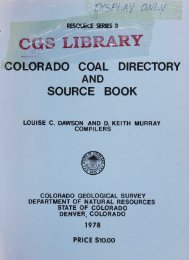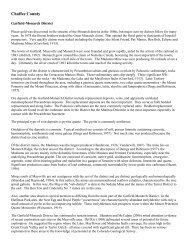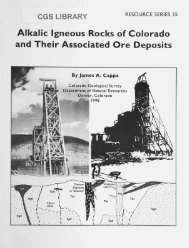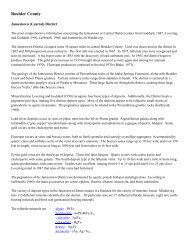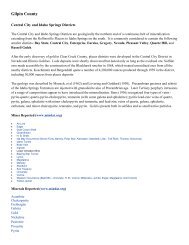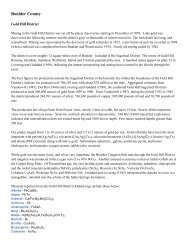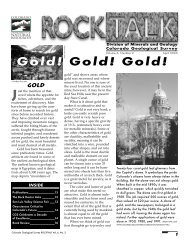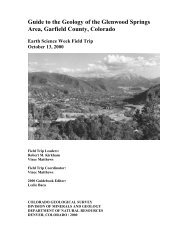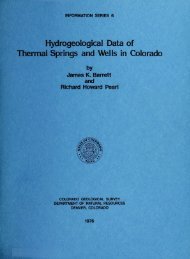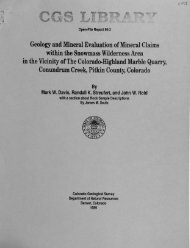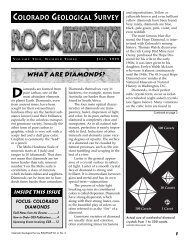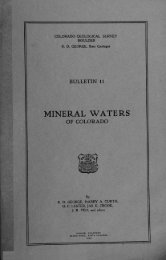Colorado Geological Survey
Colorado Geological Survey
Colorado Geological Survey
Create successful ePaper yourself
Turn your PDF publications into a flip-book with our unique Google optimized e-Paper software.
METAMORPHIC ROCKS -1<br />
east of Pando. The gneiss varies from coarse to fine grain in different<br />
localities. Essential component minerals are orthoclase, microcline, quartz,<br />
and biotite.<br />
QUARTZ-DIORITE GNEISS<br />
A small exposure of quartz-diorite gneiss is found west of the mouth<br />
oz Homestake Creek. The rock has a coarse texture and rough gneissic<br />
structure. Probably half the rock mass is composed of hornblende and<br />
biotite in nearly equal quantities. The feldspar, insofar as determinable,<br />
is plagioclase. Quartz forms about 15 per cent of the rock.<br />
GRANITIC GNEISS<br />
Gneiss that resembles granite in mineral composition, and of uncertain<br />
or mixed origin, may be called granitic gneiss. One variety is pinkishgray,<br />
and composed chiefly of quartz and feldspar. It also carries an appreciable<br />
quantity of muscovite and very little biotite. The rock may be<br />
a metamorphosed arkose or feldspathic sandstone. The proportion of<br />
feldspar is a little low for typical granite. Another vlariety bears a resemblance<br />
to the biotite gneiss described below, but contains a higher<br />
proportion of injected igneous material. A phase of this rock carries much<br />
soda-lime feldspar, and approaches granodiorite in mineral composition.<br />
MICA GNEISS<br />
The mica gneiss differs from the granitio gneiss chiefly in the much<br />
higher proportion of mjica or quartz or both. The feldspar content is low.<br />
Part or all of the rock here called mica gneiss is of sedimentary origin.<br />
The rock is dark gray or reddish-gray, and has pronounced gneissic structure.<br />
Quartz in most specimens makes up 50 to 80 per cent of the rock.<br />
The highly quartzose variety might be called a quartzite, but the pronounced<br />
banding is more characteristic of gneiss. Biotite composes about<br />
15 to 30 per cent of the rock mass. Muscovite is present in some specimens.<br />
PYROXENE GNEISS<br />
North of Yoder Gulch, about 200 feet above the railroad, is a small<br />
exposure of fine-grained pyroxene gneiss. The rock is dark in color, and<br />
contains thin veinlike streaks and lenslike patches of quartz. The most<br />
abundant mineral is pyroxene determinable only in thin section. It is<br />
grass-green to greenish-gray, monoclinic, and has a birefringence of about<br />
.028 or .029. It is probably ferriferous diopside or common pyroxene.<br />
Quartz, orthoclase, microcline, soda-lime feldspar, and a little titanite and<br />
zircon are present.<br />
SILLIMANITE GNEISS<br />
South of Eagle River, west of the mouth of Homestake Creek, is a<br />
small exposure of peculiar rock whose weathered surface shows many bluish<br />
patches of a mineral with a splintery fracture. This mineral is shown by<br />
the microscope and chemical tests to be sillimanite. Other minerals present<br />
are quartz, andesine, and biotite. Any one of the minerals may be bunched,<br />
and associated with smaller amounts of the others. That part of the rock<br />
rich in sillimanite is about one-half sillimanite in grains up to three-



